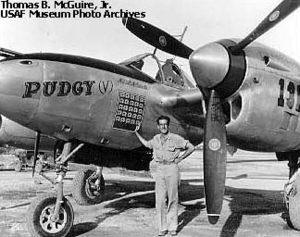
 |
| Major McGuire Crashes To His Death |
|
January 7, 1945 Major McGuire scored 38 aerial victories in a P-38, making him our nation's second highest scoring ace. Among his many decorations was the Medal of Honor awarded for his actions on December 25-26, 1944 when he shot down seven enemy aircraft. Major McGuire crashed to his death on Los Negros Island in the Philippines while risking an extremely hazardous maneuver at low altitude in an attempt to save the life of a comrade. McGuire Air Force Base in New Jersey is named in his honor. On January 7, 1945, McGuire was leading a group of four P-38s - himself, Major Jack Rittmayer (four victories), Captain Edwin Weaver (two victories) and Lieutenant Douglas Thropp (one victory) - on a fighter sweep over northern Negros Island in the central Philippines. Their aim was to gain victories. McGuire desperately wanted to pass Major Richard Bong's score of 40 kills. Descending through cloud cover, McGuire’s flight circled a Japanese airfield at Fabrica and then proceeded to a second airstrip at Manapla (also referred to as Carolina). As they approached Manapla, they were confronted by a lone Ki-43 Hayabusa (“Oscar”), which immediately engaged McGuire's flight. Flying in the number-three position, Lt. Thropp saw the Oscar trying to attack him in a head-on pass. Thropp instinctively broke hard left. The Japanese pilot turned with him and fell into position behind him while firing. Major Rittmayer, flying as Thropp's wingman, turned sharply towards and began firing on the attacker. McGuire saw that the Oscar was being engaged by Rittmayer and turned to face an imminent threat to the flight from the opposite direction. Unfortunately for McGuire and his flight, the Japanese pilot, Warrant Officer Akira Sugimoto, was an instructor pilot with some 3,000+ hours in that type of aircraft. |
 |
|
 |
|
He broke away from Thropp and Rittmayer and turned to find McGuire and his wingman Ed Weaver directly in front of him. Sugimoto was easily able to catch up and attack them from behind.As Sugimoto approached Weaver from behind, Weaver radioed he was attack and cut inside of the turn to present a more difficult shot. McGuire eased up on his turn rate in an effort to draw the attacker off of his wingman and onto himself. Sugimoto took the bait and switched his attack to McGuire. As Sugimoto approached from behind, McGuire rapidly increased his turn rate. This extremely dangerous maneuver, performed at only 300 feet above the ground, caused McGuire's P-38 to stall. It snap-rolled to an inverted position and nosed down into the ground. He was killed on impact. At the start of the dogfight, McGuire had radioed to keep their auxiliary fuel tanks, as they would need them to reach their main objective in the sweep. Many P-38 pilots believe that this order, which was contrary to standard operating procedures, was the cause of McGuire's death. The auxiliary fuel tank added extra weight and encumbered the aircraft, making it less manouevreable and more prone to stall and spin at low speeds. After McGuire's crash, Thropp caught up to Sugimoto and fired on him causing enough damage that he had to make a forced landing a few miles away from where McGuire crashed. Less than a minute later, another Japanese aircraft, a Ki-84 Hayate (“Frank”) piloted by Technical Sergeant Mizunori Fukuda, appeared from the nearby airstrip at Manapla and attacked Major Jack Rittmayer in a head-on pass. Rittmayer's P-38 disintegrated from cannon shots and pitched down into a river. Rittmayer was killed on impact. Captain Weaver observed Fukuda's attack and fired at Fukuda, severely damaging his aircraft. Fukuda later crash landed at Manapla, where his fighter was destroyed. Thropp's P-38 was slightly damaged in the action and trailed smoke from one engine. Weaver and Thropp returned to Dulag, Leyte. McGuire's crash was witnessed by Filipinos who immediately rushed to the scene and secured his body so it would not be captured. |
| ŠAvStop Online Magazine Contact Us Return To News |